
Julie Wolfthorn was a German painter. Born as Julie Wolf(f) to a middle-class Jewish family, she later styled herself as Julie Wolfthorn after Thorn (Toruń), her city of birth.

The Künstlerhaus in Vienna's 1st district has accommodated the Künstlerhaus Vereinigung since 1868. It is located in the Ringstrassenzone in between Akademiestraße, Bösendorferstraße and Musikvereinsplatz.

Erika Abels d'Albert (1896–1975) was an Austrian painter and graphic artist.

Erwin Puchinger was a Viennese painter, illustrator, industrial designer and graphic artist. He was an influential figure in Viennese art in the fin-de-siecle. Puchinger was a part of the Austrian Jugendstil and Gesamtkunstwerk movements, which sought to erase the boundaries between fine art and applied art. Puchinger worked in London, Prague and Paris as well as Vienna and collaborated with other major figures in Viennese art and design such as Ernst and Gustav Klimt and Otto Prutscher. He was a respected art professor at the Graphic Arts Institute, where he taught for more than thirty years. His work was also part of the painting event in the art competition at the 1936 Summer Olympics.

Renate Bertlmann is an Austrian feminist avant-garde visual artist, who since the early 1970s has worked on issues surrounding themes of sexuality, love, gender and eroticism within a social context, with her own body often serving as the artistic medium. Her diverse practice spans across painting, drawing, collage, photography, sculpture and performance, and actively confronts the social stereotypes assigned to masculine and feminine behaviours and relationships.

Rudolf Otto von Ottenfeld was an Austrian military painter, a founding member of the Vienna Secession and a professor at the Academy of Fine Arts, Prague.

Felician Myrbach was an Austrian painter, graphic designer and illustrator. He was a founding member of the Vienna Secession and the director of the Applied Arts School in Vienna, and was instrumental in the creation of the Wiener Werkstätte.
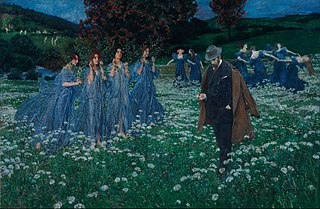
Maximilian Lenz was an Austrian painter, graphic artist and sculptor. Lenz was a founding member of the Vienna Secession; during his career's most important period, he was a Symbolist, but later his work became increasingly naturalistic. He worked in a variety of media, including oils, watercolours, lithography and metal reliefs.
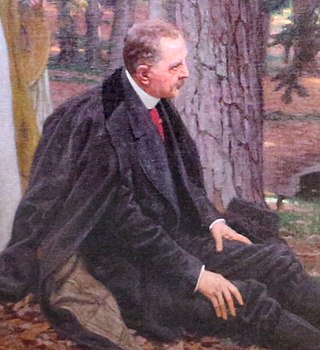
Friedrich König was an Austrian painter, illustrator and designer.
Bettina Baumgärtel is a German art historian who is head of the painting collection of the Museum Kunstpalast in Düsseldorf. She is a leading authority on the art of Angelica Kauffman and founded the Angelika Kauffmann Research Project (AKRP), of which she is the director, in 1990.
Steinbrener/Dempf & Huber, founded in 2001, is an Austrian group of artists consisting of sculptor Christoph Steinbrener, photographer and graphic designer Rainer Dempf and architect Martin Huber. It was founded in 2001.
Emma Alice Henriette Ronner was a Belgian painter.

Bertha von Tarnóczy-Sprinzenberg was an Austrian art teacher and painter, specializing in landscapes and still lifes.

Mathilde Flögl was an Austrian artist and designer. She worked in several different mediums including textiles, glass, and paint. Flögl was also a member of the Wiener Werkstätte, literally translated to the Vienna Workshops. This group was part of the Arts and Crafts movement dedicated to elegance, utility, and appropriateness. They aimed to refine art and expand it to all fields of life. Flögl was very active in this group, she participated in most of the major Wiener Werkstätte exhibitions. Currently, the Viennese Museum of Applied Arts houses over 1,600 of Flögl's works from when she was involved with the Wiener Werkstätte. Among these are many independent works and collaborations with other individuals in the group. Notable members of the Wiener Werkstätte include two of its founders Josef Hoffman and Koloman Moser as well as Gustav Klimt, among others. For the group's 25th anniversary, Flögl amassed, arranged, wrote, and published, The Wiener Werkstatte, 1903-1928: The Evolution of the Modern Applied Arts. The book itself was a work of art using elaborate materials and decoration in its pages.

Margot Pilz is an Austrian visual artist and a pioneer of conceptual and digital art in Austria. She was one of the first Austrian artists to combine computers and photography. Her works reflect the avant-garde culture of the 1960s and 1970s in their experimental techniques and performative aspects. Her work received renewed attention in the 2010s.
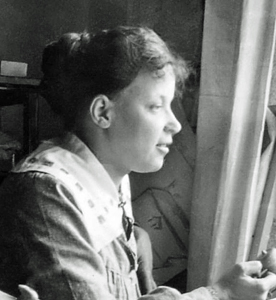
Fanny Harlfinger-Zakucka (1873-1954) was an Austrian painter, graphic artist and craftswoman.

Louise Fraenkel-Hahn (1878-1939) was an Austrian painter and founding member of the Vereinigung bildender Künstlerinnen Österreichs.
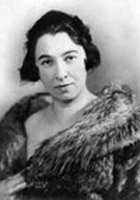
Frieda Salvendy was a Jewish Austrian painter, engraver, feminist and Holocaust refugee.
Ilse Bernheimer was an Austrian painter, graphic artist, interior designer, and teacher.
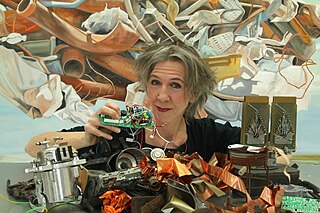
Maria Temnitschka is an Austrian artist. At the beginning of her artistic career Maria Temnitschka designed and created jewellery and objects made of metal. Later she reoriented to painting - at first abstract, since 2000 figurative representation. Her preferred techniques are oil painting, drawing, experimental photography, object art.















